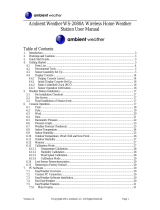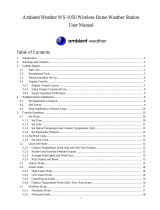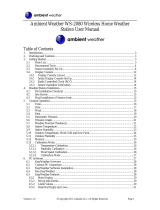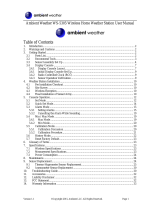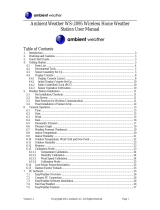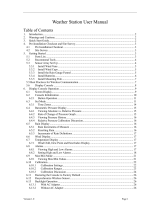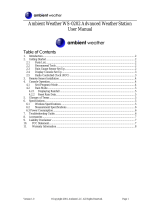Page is loading ...

Ambient Weather WS-2090 Wireless Home Weather
Station User Manual
Table of Contents
1.
Introduction ..................................................................................................................................... 3
2. Warnings and Cautions ................................................................................................................... 3
3. Getting Started ................................................................................................................................ 3
3.1 Parts List ................................................................................................................................. 3
3.2 Recommend Tools .................................................................................................................. 4
3.3 Sensor Assembly Set Up ........................................................................................................ 5
3.4 Display Console ..................................................................................................................... 8
3.4.1 Display Console Layout ..................................................................................................... 8
3.4.1 Initial Display Console Set Up ......................................................................................... 10
3.4.2 Radio Controlled Clock (RCC) ........................................................................................ 10
3.4.3 Sensor Operation Verification .......................................................................................... 10
4. Weather Station Installation .......................................................................................................... 11
4.1 Pre Installation Checkout ..................................................................................................... 11
4.2 Site Survey ........................................................................................................................... 11
4.3 Final Installation of Sensor Array......................................................................................... 11
5. Console Operation ......................................................................................................................... 13
5.1 Time...................................................................................................................................... 13
5.2 Date ...................................................................................................................................... 15
5.3 Wind ..................................................................................................................................... 15
5.4 Rain ...................................................................................................................................... 16
5.5 Barometric Pressure ............................................................................................................. 17
5.6 Pressure Graph ..................................................................................................................... 19
5.7 Weather Forecast (Tendency) ............................................................................................... 19
5.8 Indoor Temperature .............................................................................................................. 20
5.9 Indoor Humidity ................................................................................................................... 21
5.10 Outdoor Temperature, Wind Chill and Dew Point ............................................................... 22
5.11 Outdoor Humidity ................................................................................................................ 23
5.12 Memory ................................................................................................................................ 23
5.13 Restore Factory Default ........................................................................................................ 23
6. PC Software .................................................................................................................................. 23
6.1 EasyWeather Overview ........................................................................................................ 24
6.2 Connect PC Connection ....................................................................................................... 24
6.3 EasyWeather Software Installation ....................................................................................... 24
6.4 Run EasyWeather ................................................................................................................. 24
6.5 EasyWeather Features .......................................................................................................... 25
6.5.1 Main Display .................................................................................................................... 25
6.5.2 Set-up and Alarms ............................................................................................................ 25
6.5.3 Alarm Values .................................................................................................................... 26
6.5.4 Historical Highs and Lows ............................................................................................... 27
6.5.5 Historical Data ................................................................................................................. 28
6.5.6 Graph Data ....................................................................................................................... 29
6.5.7 Clearing Rainfall from EasyWeather ............................................................................... 29
6.5.8 EasyWeather Legal Notes ................................................................................................ 30
Version 1.0 ©Copyright 2012, Ambient LLC. All Rights Reserved. Page 1

Version 1.0 ©Copyright 2012, Ambient LLC. All Rights Reserved. Page 2
6.6 Reset Factory Default ........................................................................................................... 30
7. Glossary of Terms ......................................................................................................................... 30
8. Specifications ................................................................................................................................ 31
8.1 Wireless Specifications ........................................................................................................ 31
8.2 Measurement Specifications ................................................................................................. 31
8.3 Power Consumption ............................................................................................................. 31
9. Maintenance .................................................................................................................................. 31
10. Sensor Replacement ................................................................................................................. 31
10.1 Thermo-Hygrometer Sensor Replacement ........................................................................... 32
10.2 Anemometer Sensor Replacement ....................................................................................... 37
11. Troubleshooting Guide ............................................................................................................. 37
12. Accessories ............................................................................................................................... 39
13. Liability Disclaimer .................................................................................................................. 39
14. FCC Statement .......................................................................................................................... 39
15. Warranty Information ............................................................................................................... 40

1. Introduction
Thank you for your purchase of the Ambient Weather WS-2900 wireless weather station. The
following user guide provides step by step instructions for installation, operation, maintenance and
troubleshooting. To download the latest manual and additional troubleshooting tips, please visit:
http://ambientweather.wikispaces.com/ws2900
2. Warnings and Cautions
Warning: Any metal object may attract a lightning strike, including your weather station
mounting pole. Never install the weather station in a storm.
Warning: Installing your weather station in a high location may result in injury or death.
Perform as much of the initial check out and operation on the ground and inside a building or home.
Only install the weather station on a clear, dry day.
3. Getting Started
The WS-2900 weather station consists of a display console (receiver), a sensor array with
thermo-hygrometer, rain gauge, wind direction sensor, wind speed sensor (also referred to as the
sensor array or transmitter), and mounting hardware.
3.1 Parts List
The WS-2900 weather station consists of the following parts (as referenced in Figure 1 and Figure 2).
QTY Item
1 Display Console
Frame Dimensions (LxWxH): 6.75” x 4.5” x 1.25”
LCD Dimensions (LxW): 4.5” x 3.5”
1 USB cable (L: 41”)
1 Easy Weather CD
1 Thermo-hygrometer / Rain Gauge / Wind Vane / Wind Speed Sensor (sensor array or
Transmitter)
1 Sensor mounting bracket
2 Pole mounting U-bolt
4 Pole mounting clamps
4 Pole mounting nuts
Version 1.0 ©Copyright 2012, Ambient LLC. All Rights Reserved. Page 3

Figure 1
Figure 2
3.2 Recommend Tools
• Precision screwdriver (for small Phillips screws)
• Compass or GPS (for wind direction calibration)
• Adjustable Wrench
Version 1.0 ©Copyright 2012, Ambient LLC. All Rights Reserved. Page 4

3.3 Sensor Assembly Set Up
1. Insert batteries into the thermo-hygrometer / rain gauge transmitter. Locate the battery
door on the thermo-hygrometer / rain gauge transmitter, as shown in Figure 3. Turn the set
screw counter clockwise to loosen the screw, and rotate the sheet metal bracket to open the
battery compartment.
Figure 3
Version 1.0 ©Copyright 2012, Ambient LLC. All Rights Reserved. Page 5

Insert 2 x AA batteries in the battery compartment, as shown in Figure 5.
Note: Do not install the batteries backwards. You can permanently damage the
thermo-hygrometer. Do not use rechargeable batteries.
Note: We recommend installing Lithium AA batteries:
http://www.ambientweather.com/enaaliba4pa.html
Lithium batteries provide longer life and operate in colder temperatures.
Figure 5
Reinsert the battery compartment into the thermo-hygrometer / rain gauge transmitter (hold upright so
the batteries do not slide out), and close the battery compartment door and tighten the set screw.
The LED on the back of the rain collector will turn on for four seconds and normally flash once every
45 seconds (the sensor transmission update period).
Version 1.0 ©Copyright 2012, Ambient LLC. All Rights Reserved. Page 7

2. Attach the wind cups to the anemometer assembly. Push the wind cups into the
anemometer shaft, as shown in Figure 6.
Tighten the set screw with the Allen Wrench (included), as shown in Figure 6. Make sure
the wind cups spin freely.
Figure 6
3.4 Display Console
3.4.1 Display Console Layout
The display console layout is shown in Figure 7.
Version 1.0 ©Copyright 2012, Ambient LLC. All Rights Reserved. Page 8

7.
1.
8.
9.
2.
10.
3.
11.
4.
5. 12.
13.
6.
14.
Figure 7
1. Time
2. Wind direction
3. Barometric Pressure
4. Barometric trend
5. Indoor Temperature
6. Outdoor Temperature
7. Memory
8. Radio Controlled Clock (RCC)
9. Date
10. Rainfall
11. Weather Forecast
12. Indoor Humidity
13. Outdoor reception signal
14. Outdoor Humidity
Version 1.0 ©Copyright 2012, Ambient LLC. All Rights Reserved. Page 9

3.4.1 Initial Display Console Set Up
Note: The sensor array must be powered and updating before powering up the console, or the
console will timeout searching for the sensors. Perform this step last.
Make certain the weather station sensor array is at least 10’ away from the console and within 300’ of
the console. If the weather station is too close or two far away, it will not receive a proper signal.
Insert two AA batteries into the battery compartment on the back of the display. After inserting the
batteries into the console, all of the LCD segments will light up for a few seconds to verify all
segments are operating properly.
The unit will instantly display indoor temperature, humidity, barometer, tendency, date and time.
The wind speed, wind direction, rain, and outdoor temperature and humidity will update on the
display within a few minutes. Do not Press any menu keys until the outside transmitter report in,
otherwise the outdoor sensor search mode will be terminated. When the outdoor transmitter data has
been received, the console will automatically switch to the normal mode from which all further
settings can be performed.
If it does not update, please reference the troubleshooting guide in Section 9.
3.4.2 Radio Controlled Clock (RCC)
After the remote sensor is powered up, the sensor will transmit weather data for 30 seconds, and then
the sensor will begin radio controlled clock (RCC) reception. During the RCC time reception period
(maximum 10 minutes), no weather data will be transmitted to avoid interference.
If the signal reception is not successful within 1 minute, the signal search will be cancelled and will
automatically resume every two hours until the signal is successfully captured. The regular RF link
will resume once RCC reception routine is finished. In some locations, RCC reception may take a
couple of days to receive the signal.
3.4.3 Sensor Operation Verification
The following steps verify proper operation of the sensors prior to installing the sensor array.
1. Verify proper operation of the rain gauge. Tip the sensor array back and forth several times.
You should hear a “clicking” sound within the rain gauge. Verify the rain reading on the
display console is not reading 0.00. Each “click” represents 0.01 inches of rainfall.
2. Verify proper operating of the wind speed. Rotate the wind cups manually or with a
constant speed fan. Verify the wind speed is not reading 0.0.
3. Verify proper operation of the indoor and outdoor temperature. Verify the indoor and
outdoor temperature match closely with the console and sensor array in the same location
(about 10’ apart). The sensors should be within 4°F (2°C) (the accuracy is ± 2°F / 1°C).
Allow about 30 minutes for both sensors to stabilize.
4. Verify proper operation of the indoor and outdoor humidity. Verify the indoor and
outdoor humidity match closely with the console and sensor array in the same location (about
10’ apart). The sensors should be within 8% (the accuracy is ± 4%). Allow about 30 minutes
for both sensors to stabilize.
Version 1.0 ©Copyright 2012, Ambient LLC. All Rights Reserved. Page 10

Version 1.0 ©Copyright 2012, Ambient LLC. All Rights Reserved. Page 11
4. Weather Station Installation
4.1 Pre Installation Checkout
Before installing your weather station in the permanent location, we recommend operating the
weather station for a few days in a temporary location with easy access. This will allow you to
check out all of the functions, insure proper operation, and familiarize you with the weather station
and calibration procedures. This will also allow you to test the wireless range of the weather station.
4.2 Site Survey
Perform a site survey before installing the weather station. Consider the following:
1. You must clean the rain gauge once per year and change the batteries every two years.
Provide easy access to the weather station.
2. Avoid radiant heat transfer from buildings and structures. In general, install the sensor array at
least 5’ from any building, structure, ground, or roof top.
3. Avoid wind and rain obstructions. The rule of thumb is to install the sensor array at least four
times the distance of the height of the tallest obstruction. For example, if the building is 20’
tall, install 4 x 20’ = 80’ away. Use common sense. If the weather station is installed next to a
tall building, the wind and rain will not be accurate.
4. Wireless Range. The radio communication between receiver and transmitter in an open field
can reach a distance of up to 300 feet, providing there are no interfering obstacles such as
buildings, trees, vehicles, high voltage lines. Wireless signals will not penetrate metal
buildings. Most applications will only reach 100 feet due to building obstructions, walls and
interference.
5. Radio interference such as PCs, radios or TV sets can, in the worst case, entirely cut off radio
communication. Please take this into consideration when choosing console or mounting
locations.
6. Visit Ambient Weather Mounting Solutions for assistance and ideas for mounting your
weather station:
http://www.ambientweather.com/amwemoso.html
4.3 Final Installation of Sensor Array
Prior to installation, you will need to calibrate the wind direction. There is a “S” indicator on the wind
vane that indicates South, as shown in Figure 8. Align this “S” marker in the direction of South.

Version 1.0 ©Copyright 2012, Ambient LLC. All Rights Reserved. Page 12
Figure 8
Fasten the mounting pole to your mounting pole or bracket (purchased separately) with the two
U-bolts, mounting pole brackets and nuts, as shown in Figure 2.
Tighten the mounting pole to your mounting pole with the U-Bolt assembly, as shown in Figure 9.

Version 1.0 ©Copyright 2012, Ambient LLC. All Rights Reserved. Page 13
Figure 9
5. Console Operation
Note: The display console has six keys for basic operation: menu key, up key, down key, enter
key, history key, and on/off key.
To enter the Set mode, press the menu key. The Set mode can be exited at any time by either
pressing the history key or waiting for the 30-second time-out to take effect. You can skip over any
setting by pressing the menu key again.
Holding the
up or down key when in the Set mode will increase/decrease values rapidly.
5.1 Time
Press the menu key to enter the TIME Set Mode. You can skip over any setting by selecting the enter
key.
Figure 10
1. Display (LCD) Contrast Level. The display contrast value will begin flashing (example,
lcd0 thru lcd8). The lowest LCD contrast level 0 and the highest LCD contrast level is 8.

Version 1.0 ©Copyright 2012, Ambient LLC. All Rights Reserved. Page 14
Press the up key or down key to adjust the contrast level from 0 to 8 (the default is 5).
2. Time Zone. Press the enter key to display the time zone. The time zone value will begin
flashing.
Press the up key or down key to adjust the time zone from -12 to 12, based on the number of
hours from Coordinated Universal Time, or Greenwich Mean Time (GMT).
The following table provides times zones throughout the world. Locations in the eastern
hemisphere are positive, and locations in the western hemisphere are negative.
Hours from
GMT
Time Zone Cities
-12 IDLW: International Date Line West ---
-11 NT: Nome Nome, AK
-10 AHST: Alaska-Hawaii Standard
CAT: Central Alaska
HST: Hawaii Standard
Honolulu, HI
-9 YST: Yukon Standard Yukon Territory
-8 PST: Pacific Standard Los Angeles, CA, USA
-7 MST: Mountain Standard Denver, CO, USA
-6 CST: Central Standard Chicago, IL, USA
-5 EST: Eastern Standard New York, NY, USA
-4 AST: Atlantic Standard Caracas
-3 --- São Paulo, Brazil
-2 AT: Azores Azores, Cape Verde Islands
-1 WAT: West Africa ---
0 GMT: Greenwich Mean
WET: Western European
London, England
1 CET: Central European Paris, France
2 EET: Eastern European Athens, Greece
3 BT: Baghdad Moscow, Russia
4 --- Abu Dhabi, UAE
5 --- Tashkent
6 --- Astana
7 --- Bangkok
8 CCT: China Coast Bejing
9 JST: Japan Standard Tokyo
10 GST: Guam Standard Sydney
11 --- Magadan
12 IDLE: International Date Line East
NZST: New Zealand Standard
Wellington, New Zealand
3. 12/24 Hour Format. Press the enter key to change the 12/24 hour format. Press the up key
or down key to alternate the display unit between 12 hour format and 24 hour format.
4. Daylight Saving Time. Press the enter key to turn ON and OFF daylight savings time (DST)
observance (example, Arizona and parts of Indiana do not observe daylight savings time).
Press the on/off key to alternate the display unit between ON and OFF.
5. Change Hour. Press the enter key to set the hour. Press the up key or down key to change

the hour setting. The RCC time will override the manual set time.
6. Change Minute. Press the enter key to set the minute. Press the up key or down key to
change the minute setting. Manually setting the time overrides the automatic RCC time.
5.2 Date
Note: This is a continuation of the previous section. To enter this mode, you must begin at
Section 5.1 and proceed to this section.
Press the
menu key to enter the Date Set Mode. You can skip over any setting by selecting the enter
key.
Figure 11
1. Alarm Time, Date and Date of the Week. The date will be flashing.
Press the up key or down key to alternate the display between the alarm time, and date and
week date.
2. Date Format Press the enter key to display the date format (Md for month/day or Dm for
Day/Month). The date value will begin flashing.
Press
the up key or down key to adjust the alternate the display between the DD-MM format
and MM-DD format for the date.
3. Change Year. Press the enter key to set the year. The year will begin flashing. Press the up
key or down key to change the year setting.
4. Change Month. Press the enter key to set the month. The month will begin flashing. Press
the up key or down key to change the month setting.
5. Change Day. Press the enter key to set the day. The day will begin flashing. Press the up
key or down key to change the day setting.
6. Change Alarm Hour. Press the enter key to set the alarm hour. The alarm hour and ALARM
will begin flashing. Press the up key or down key to change the alarm hour setting.
7. Change Alarm Minute. Press the enter key to set the alarm minute. The alarm minute will
begin flashing. Press the up key or down key to change the alarm minute setting.
Press the ON/OFF key to select the alarm on or off (if the alarm is enabled, the alarm icon
will be turned on in the Time section).
5.3 Wind
Note: This is a continuation of the previous section. To enter this mode, you must begin at
Section 5.1 and proceed to this section.
Version 1.0 ©Copyright 2012, Ambient LLC. All Rights Reserved. Page 15

Press the menu key to enter the Wind Set Mode. You can skip over any setting by selecting the enter
key.
Figure 12
1. Average Wind Speed and Wind Gust. Press the up key or down key to alternate the
display between the 48 second Wind Speed Average and Gust Speed (or the maximum wind
speed in the update period).
2. Wind Speed Units. Press the enter key to set the wind speed units. The wind speed units will
begin flashing.
Press the up key or down key to alternate the display unit between km/h, mph, m/s, knots,
and bft (or Beaufort scale).
3. Wind Speed High Alarm. Press the enter key to set the wind speed high alarm setting. The
wind speed high alarm and HI AL (high alarm) will begin flashing.
Press the up key or down key to adjust the high wind speed alarm.
Press the ON/OFF key to select the alarm on or off (if the alarm is enabled, the alarm icon
will be turned on).
4. Wind Direction Alarm. Press the enter key to set the wind direction alarm setting. The wind
direction alarm and Direct (wind direction) will begin flashing.
Press the up key or down key to adjust the wind direction alarm.
Press the ON/OFF key to select the alarm on or off (if the alarm is enabled, the alarm icon
will be turned on).
5. Wind Speed Record High. Press the enter key to display maximum wind speed record since
the last reset. The maximum record will be flashing, and the MAX icon will light up (in the
tendency section). To reset, press the enter key for 3 seconds, and the maximum value (and
associated date and time) (and associated date and time) will be reset to current reading.
5.4 Rain
Note: This is a continuation of the previous section. To enter this mode, you must begin at
Section 5.1 and proceed to this section.
Version 1.0 ©Copyright 2012, Ambient LLC. All Rights Reserved. Page 16

Press the menu key to enter the Rain Set Mode. You can skip over any setting by selecting the enter
key.
Figure 13
1. Rain Increment. Press the up key or down key to alternate the display between 1 hour, 24
hour, week, month and total rain increments.
2. Rain Units. Press the enter key to set the rain units. The rain units will begin flashing.
Press the up key or down key to alternate the display unit between inches and mm.
Rain High Alarm. Press the enter key to set the rain high alarm function. The rain high
alarm and HI AL (high alarm) will begin flashing.
Press the up key or down key to adjust the rain alarm.
Press the ON/OFF key to select the alarm on or off (if the alarm is enabled, the alarm icon
will be turned on).
3. Rain Record High. Press the enter key to display maximum rain record since the last reset.
The maximum record will be flashing, and the MAX icon will light up (in the tendency
section). To reset, press the enter key for 3 seconds, and the maximum value (and associated
date and time) will be reset to current reading.
4. Reset Rain. Press the enter key to reset the rain values. The rain and CLEAR will begin
flashing. To reset, press enter key for 3 seconds and the 1 hour, 24 hour, week, month and
total rain will reset to 0.
5.5 Barometric Pressure
Note: The weather station console displays two different pressures: absolute (measured) and
relative (corrected to sea-level).
To compare pressure conditions from one location to another, meteorologists correct pressure to
sea-level conditions. Because the air pressure decreases as you rise in altitude, the sea-level corrected
pressure (the pressure your location would be at if located at sea-level) is generally higher than your
measured pressure.
Thus, your absolute pressure may read 28.62 inHg (969 mb) at an altitude of 1000 feet (305 m), but
the relative pressure is 30.00 inHg (1016 mb).
The standard sea-level pressure is 29.92 in Hg (1013 mb). This is the average sea-level pressure
around the world. Relative pressure measurements greater than 29.92 inHg (1013 mb) are
Version 1.0 ©Copyright 2012, Ambient LLC. All Rights Reserved. Page 17

considered high pressure and relative pressure measurements less than 29.92 inHg are considered low
pressure.
To determine the relative pressure for your location, locate an official reporting station near you (the
internet is best source for real time barometer conditions, such as Weather.com or Wunderground.com),
and set your weather station to match the official reporting station.
Note: This is a continuation of the previous section. To enter this mode, you must begin at
Section 5.1 and proceed to this section.
Press the
menu key to enter the Pressure Mode. You can skip over any setting by selecting the enter
key.
Figure 14
1. Relative vs. Absolute Pressure Display. Press the up key or down key to alternate the
display between relative (rel) pressure and absolute (abs) pressure.
2. Pressure Units. Press the enter key to set the pressure units. The pressure units will begin
flashing.
Press the up key or down key to alternate the display unit between hPa, inHg and mmHg.
3. Relative Pressure Calibration. When Absolute (abs) pressure is selected, this step will be
skipped.
Press the enter key to set the relative pressure calibration. The relative pressure will flash.
Press the up key or down key to change the value.
4. Pressure High Alarm. Press the enter key to set the pressure high alarm function. Pressure
and HI AL (high alarm) icon will flash.
Press the up key or down key to change the value.
Press the ON/OFF key to select the alarm on or off (if the alarm is enabled, the alarm icon
will be turned on).
5. Pressure Low Alarm. Press the enter key to set the pressure low alarm function. Pressure
and LO AL (high alarm) icon will flash.
Press the up key or down key to change the value.
Version 1.0 ©Copyright 2012, Ambient LLC. All Rights Reserved. Page 18

Press the ON/OFF key to select the alarm on or off (if the alarm is enabled, the alarm icon
will be turned on).
6. Pressure Record High. Press the enter key to display maximum pressure record since the
last reset. The maximum record will be flashing, and the MAX icon will light up (in the
tendency section). To reset, press the enter key for 3 seconds, and the maximum value (and
associated date and time) (and associated date and time) will be reset to current reading.
7. Pressure Record Low. Press the enter key to display minimum pressure record since the last
reset. The minimum record will be flashing, and the MIN icon will light up (in the tendency
section). To reset, press the enter key for 3 seconds, and the minimum value (and associated
date and time) will be reset to current reading.
5.6 Pressure Graph
Note: The weather station bar graph flashes from left to right to prevent screen burn in. This
feature cannot be turned off.
Note: This is a continuation of the previous section. To enter this mode, you must begin at
Section 5.1 and proceed to this section.
Press the enter key to set the pressure graph history time axis. The pressure graph time axis will begin
flashing.
Press the up key or down key to change the pressure history time axis between 12 hours and 24
hours.
5.7 Weather Forecast (Tendency)
Note: The weather forecast or pressure tendency is based in the rate of change of barometric
pressure. In general, when the pressure increases, the weather improves (sunny to partly cloudy) and
when the pressure decreases, the weather degrades (cloudy to rain).
The weather forecast is an estimation or generalization of weather changes in the next 24 to 48 hours,
and varies from location to location. The tendency is simply a tool for projecting weather conditions
and is never to be relied upon as an accurate method to predict the weather.
Note: This is a continuation of the previous section. To enter this mode, you must begin at
Section 5.1 and proceed to this section.
Press the
menu key to enter the TENDANCY Set Mode. You can skip over any setting by selecting
the enter key.
Version 1.0 ©Copyright 2012, Ambient LLC. All Rights Reserved. Page 19

Figure 15
1. Change Tendency. Press the up key or down key
to alternate the display between SUNNY,
PARTLY CLOUDY and CLOUDY, and RAINY.
2. Pressure Threshold. Press the enter key to change the pressure threshold. The up and down
arrow and pressure tendency will be flashing. Press the up key or down key to adjust the
pressure threshold from 2.0 to 4.0 hPa/hr (the default is 2 hPa/hr).
3. Storm Threshold. Press the enter key to change the storm threshold. The up and down arrow
and pressure tendency will be flashing. Press the up key or down key to adjust the pressure
threshold from 3.0 to 9.0 hPa/hr (the default is 4 hPa/hr).
5.8 Indoor Temperature
Note: This is a continuation of the previous section. To enter this mode, you must begin at
Section 5.1 and proceed to this section.
Press the
menu key to enter the INDOOR TEMPERATURE Set Mode. You can skip over any setting
by selecting the enter key.
Figure 16
1. Indoor Temperature Units. Press the up key or down key to alternate the display unit
between °C and °F.
2. Indoor Temperature High Alarm. Press the enter key to set the indoor temperature high
alarm function. The indoor temperature and HI AL (high alarm) will begin flashing.
Press the up key or down key to change the value.
Press the ON/OFF key to select the alarm on or off (if the alarm is enabled, the alarm icon
Version 1.0 ©Copyright 2012, Ambient LLC. All Rights Reserved. Page 20
/

